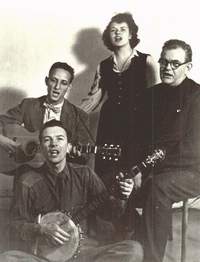Folk Music And Banjos
Another direction banjo took was in the hands of folk musicians.
What is Folk Music? As defined by Pete Seeger.
The term "folk music" was invented by nineteenth-century scholars
to describe the music of peasantry, age-old and anonymous. Nowadays
it covers such a multitude of sins as to be almost meaningless. To me it
means homemade-type music played mainly by ear, arising out of older
traditions but with a meaning for today. I use it only for lack of a
better word. Similarly, I have had to accept the label "folksinger,"
although "a professional singer of amateur music" would be more accurate
in my own case. (Seeger, 1972, p. 5).
Folk music
original tales of the common man, took a new meaning in America begining
with Folk composers such as Woodie Guthrie who attempted to make social
changes by making music a tool for awareness. In the late 40s and early
50s this idea caught on. Many folk artists believed that armed only with
music they could advocate social changes. One such group, and one of this
authors personal favorites was The Weavers. Banjoist Pete Seeger is this
pages featured artist. A man who has accomplished much with a banjo as his tool.
|

Pete Seeger
Soundclip
This Land Was Made For You And Me
(The Weavers)
|
Pete Seeger was born in Patterson, New
York, son of Charles and Constance Seeger.
In 1936 he heard the five string banjo for the first time at
the Folk Song and Dance Festival in Asheville, North Carolina, and his
life was changed forever.
In the 1940s he traveled the land with Woody Guthrie, performing
at union meetings and striker's demonstrations. He privately published
"How to Play the Five String Banjo" and then refused to copyright it
because he felt the banjo belongs to everyone.
In the late '40s, he and Lee Hays co wrote
"If I Had A Hammer," a song about the need for reform and justice a call
of conscience to a nation healing from the bitterness of war.
This song has been one of the most recorded songs ever written.
Its message is still current today, as the need for justice is a timeless element.
|
|
By 1950 Hays and Seeger, along with Fred Hellerman and Ronnie Gilbert,
formed The Weavers and enjoyed success with "Goodnight Irene"
and other folk tunes. Many times in their presentations, they would take
a moment to teach the audience about the history and backround of the songs
using music to educate as well as entertain. They used music as a history
lesson, in the feelings and convictions and experiences and many times dreams, of the common man.
Their reportoire was broad from Cowboys laments to Sailors Chanties. A remarkable group, they
set the standard for Peter Paul and Mary, the Kingston Trio, and many other folk bands that would follow.
|
 The Weavers
The Weavers
|
During the political witch hunts of the 1950s, Pete Seeger's social
conscience made him a popular target. As quickly as The Weavers
were succesfull they were soon blacklisted and had many performances
cancelled at the last minute.
In 1955 Seeger was subpoenaed by the House Un-American Activities
Committee and became one of the few witnesses called that year who didn't
invoke the Fifth Amendment. In a dramatic appearance before the
committee, Seeger claimed that to discuss his political views and
associates violated his First Amendment rights. He was found guilty
of contempt of Congress and sentenced to 10 years in prison
but but was set free on a technical error.
Petes social activism continued in the songs he wrote such as
"Where Have All The Flowers Gone". He was involved in the civil
rights movement in the South and is most notably known for his
contribution to Dr Martin Luther King, the song that became an anthem
for the black movement, an adaptation of an old hymn, into "We Shall Overcome".
Pete plays in a unique style, an up picking method which sounds like
a mixture of clawhammer some 3 finger and some plectrum.
Early on he
played a Standard Orpheum #2, and a standard length old Vega Tubaphone.
He had the Orpheum neck "converted" to a long neck, by Marty Cohen in the
50's. It was Marty's idea to add 3 frets instead of just 2 extra.
The neck was not very stable.
Pete handcarved a neck out of solid lignum vitae
and after screwing up the fret scale had John D'Angelico refret it correctly.
On the Tubaphone rim, the one Pete usually plays,
it has "This machine surrounds hate and forces it to surrender" written on the head.
A quote taken from Woody Guthrie's guitar which had "fascists" instead of
"hate".
(see footnote)
*The Vega Company presented him with a custom longneck Tubaphone in the late
50's using a 20's vintage Tubaphone Deluxe rim and block inlays on the neck.
Pete gave that banjo to his sister Peggy she still uses it.*
He had Vega make another with simpler dot inlay and it is the one that
became the "icon" for 60's folksingers.
In typical Seeger fashion, he gave away that banjo as a "prize"
to benefit a charity in the 70's.
One of the things he has done which is not
often talked about is he endorsed bluegrass music as a kind
of folk music. Both bluegrass and folk music share the roots
of the common man, Pete recognized this and often endorsed
bluegrass bands as kindred souls. He openly did this at the
colleges holding folk festivals. He also included a chapter on bluegrass
banjo in his book.
This greatly helped bluegrass bands in the late
50s and early 60s who were competing against rock and roll, in both creating
and finding new audiences to play to, and new Bluegrass festivals.
Petes involvement in social changes continued in the sixties with
anti war songs. Today his activism is directed at enviromental issues.
For more than fifty years, Pete Seeger has been using his banjo
and music to try to build a better America. A legacy of worth
built upon idealism and optimism.
He has recorded many albums on Folklore Records.
Pete Seegers work with The Weavers paved the doors for other folk
groups. Banjoist David Guard working with The Kingston Trio had
success with the song "Tom Dooley" in 58, others also began.
The Limeliters, Brothers Four, Smothers Brothers, and eventualy
Peter, Paul and Mary all contributed to the rise of Folk Music.
This resurgance helped bluegrass cope against the rise of Rock and
Roll in the late 50s and early 60s. However the greatest force for
affecting banjo music must be credited to one man in the 20th century.
Update May 3 2009 Pete Turns 90
See him on You Tube
* This passage of information was incorrect,
it was challenged by a reader to this
website named Pete Curry. To be honest I cant recall my source on it
as I lost most of my research files due to a virus attack. So in the interest of
keeping this record as truthful as possible, here's the letter he sent me.
Following receiving this letter a 2nd source confirmed this is the truth of the
matter. Thanks Pete for the correction.
Dear Michael: I e-mailed the question about Peggy Seeger's to her Webmaster.
Following is my message, then the reply I got from Peggy herself. Hope this
sets the record straight to your satisfaction.
Kindest regards, Pete Curry
My message to her Webmaster:
I read at a Web site recently that Peggy got her trademark long-neck Vega
Tubaphone with the "block and dot" fingerboard inlays as a gift from her
half-brother Pete. Yet the late banjo collector Walter Scott told me that
Peggy told him she ordered that banjo from the Vega Company. Would you be
kind enough to ask her which version is correct?
Thank you very much, Peter J
Curry
Here's Peggy reply:
Ain't folklore wonderful! I ordered and designed it myself, from Vega, in
1955, in the spring. Pete gave and taught so many many things - but no gift
of a banjo.
Kindest regards, peggy
|
MORE ABOUT
|

